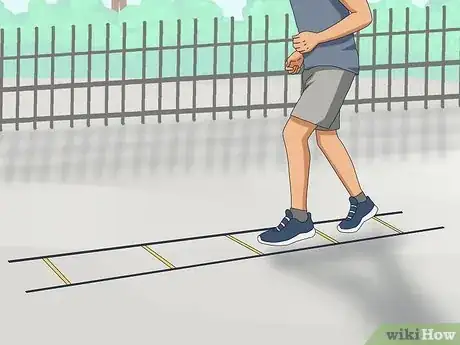This article was co-authored by Francisco Gomez. Francisco Gomez is the Head Coach at the FIT Potato Gym, a training gym established in 2001 in the San Francisco Bay Area. Francisco is a former competitive runner who helps endurance athletes train for major marathons like the Boston Marathon. Francisco specializes in Injury Rehab, Flexibility, Marathon Training, and Senior Fitness. He has a B.S. in Nutrition and Exercise Physiology & Running.
There are 11 references cited in this article, which can be found at the bottom of the page.
wikiHow marks an article as reader-approved once it receives enough positive feedback. In this case, several readers have written to tell us that this article was helpful to them, earning it our reader-approved status.
This article has been viewed 540,369 times.
Whether you’re a seasoned runner who’s looking for the best way to approach an upcoming track meet, or you’re a beginner who just wants to make the team, you may be wondering how to prepare. If track meets or tryouts are coming up and you don’t know what to do, don’t panic. There are many ways that you can strengthen your body and mind so that you’re ready to be the best track athlete you can be.
Steps
Track Season Prep
-
1Try a ladder workout. Ladder workouts, or pyramid workouts, involve starting with a short distance, gradually working up to a longer distance, and then working your way back down to the original shorter distance. For example, run 200 metres (0.12 mi), 400 metres (0.25 mi), 800 metres (0.50 mi), 400 metres (0.25 mi), and then 200 metres (0.12 mi) at a medium pace with 2-3 minutes of rest in between.
- This kind of workout can improve your endurance and pacing.
- You can also do reverse ladder workouts, where you start at a longer distance, work your way down to a shorter distance, and then finish at the longest original distance.
- Do this type of workout 2-3 times each week when getting into shape for track season.
-
2Run shorter distances repeatedly to improve your speed. Practice running 100 metres (110 yd) and/or 200 metres (220 yd) over and over again to improve your sprinting ability. Focusing on these shorter distances may help you to develop speed, pacing ability, and strength.[1]
- Try doing a workout where you run 4 total laps. Run continuously as you sprint the 100 m (110 yd) straightaways and jog the 100 m (110 yd) curves of each lap.
- For best results, focus on sprinting shorter distances 2-3 times each week.
Advertisement -
3Run longer distances repeatedly to improve your endurance. Focus on running longer distances over and over again to prepare your body for distance events. Run 800 metres (0.50 mi) and 1,600 metres (0.99 mi) at a time during your workouts to gain endurance.[2]
- Try doing a workout where you jog 1,000 metres (0.62 mi) 5 times with a 90-second resting break between each one.
- To successfully gain endurance, focus on running longer distances 2 or 3 times every week.
- Slow, easy miles will help you gradually prepare your body for track.[3]
-
4Do lower body strength training once or twice a week. While running is the more obvious way to condition your body for running track, lifting weights is necessary for strengthening your muscles effectively. Incorporate lower body strength training exercises into your workouts 1-2 times each week to build up your leg muscles for running. Some exercises you can try include:[4]
- Squats
- Forward lunges
- Calf raises
- Situps
-
5Add in weekly upper body strength training. While it may not seem like it, building your upper body is also very important for running track. Your chest, shoulders, and arms should be strong for driving your arms as you run, and a strong back may help you to maintain good posture while running. Try to incorporate some of the following upper body strength training exercises into your workouts about once a week:[5]
-
6Eat healthy, balanced meals. At track practice each day, you’ll be exerting a lot of energy. Because of this, it’s important to eat healthy meals that can effectively provide the nutrients that your body needs. Eat an energizing breakfast each day to kickstart your metabolism and a lunch that contains both protein and leafy greens. Eat foods that are high in protein and carbohydrates just after your workouts.[6]
- Try eating oatmeal with berries or a couple of eggs, a piece of toast, and a glass of orange juice for breakfast.
- Consider eating a grilled chicken breast with a big salad that has carrots, cucumbers, and peppers in it for lunch.
- Incorporate spaghetti and marinara sauce, potatoes, lean meats, and/or fava beans into your post-workout meals.
-
7Ask your coach for advice. It’s a good idea to approach the track season with a few goals in mind. Bring up your weaknesses with your coach and ask them if they can help you improve in those areas. This may help you make progress and also get closer to your coach.
- If you’re struggling with a certain physical setback, such as pacing or hurdling form, ask your coach for advice on how to get better.
- You can also talk to your coach about how to handle certain mental struggles, such as dealing with a big loss.
Meet Prep
-
1Get 9-10 hours of sleep the night before. As an athlete, you’ll need to sleep more in order to give your body the proper amount of rest and recovery time. This will allow your body to perform as well as possible.
- Try to get a minimum of 8 hours of sleep the night before you compete in a meet. Getting 9 or 10 hours is even better.
-
2Drink at least 6-8 glasses of water throughout the day. Exerting yourself will make you sweat and lose a significant amount of the water in your body. Fill up your water bottle before starting your day and keep it on you all day long so that you can stay hydrated.[7]
- Once you drink it all, refill your water bottle and continue drinking it throughout the day.
-
3Eat healthy, light snacks before the meet. If there’s a lot of time between the last meal you ate and the event you’re competing in, eat a healthy snack or 2 to keep yourself strong, focused, and energized.[8]
- Go with something small and light, like a piece of fruit and/or a granola bar, to avoid getting lightheaded or upsetting your stomach.
-
4Try to keep a positive mindset. When you’re about to compete, it’s important to think optimistically. It can be easy to let the pressure get the best of you, but that will only stress you out and possibly hinder your performance. When negative thoughts of self-doubt pop into your head, give yourself positive reminders, such as:
- You’ve prepared the best you can, and that’s what matters.
- You are capable of doing well.
- Everything happens for a reason.
-
5Listen to music. Listening to music can help you stay focused before the meet by tuning out the high-pressure environment and eliminating distractions. Listen to rap, rock, or dance music to get yourself positively pumped up for your event. Try listening to slower soothing music if you want to relax your mind.
-
6Jog 2 laps slowly. Before you start exerting your body, you’ll need to get your muscles loose. Start off by jogging around the track 2 times at a very slow, conversational pace.[9]
- 2 laps is the equivalent of 800 metres (0.50 mi).
-
7Do static stretching for at least 15 minutes. Static stretching involves holding a position for 10 seconds while staying still.[10] After you’ve done a little jogging, static stretching will help you continue to loosen up your muscles. Stretch for a total of at least 15 minutes to get your body properly stretched. Some basic static stretches you can do include:[11]
- Standing hamstring stretch
- Standing quadriceps stretch
- Side lunge stretch
- Butterfly stretch
- Prone calf stretch[12]
-
8Do dynamic warm up exercises for another 15 minutes. After doing some static stretches, move on to dynamic stretches, which involve movement. These have many benefits in addition to activating your muscles, including improving your range of motion and body awareness. Some dynamic stretches include:[13]
- Knee to chest
- A-skips
- B-skips
- High knees
- Butt kicks[14]
Trying Track
-
1Get a sports physical. Before you start running track, go to the doctor and get a physical to make sure that it’s safe for you to run. During the physical, you’ll fill out information about your medical history and be examined physically by the doctor.[15]
- You may have the opportunity to get a physical done at school. If not, make an appointment with your primary care physician.
-
2Get athletic clothes, shoes, and equipment. You’ll need to get a few different things to wear and use at practices and meets. Get some athletic clothes, such as gym shorts, athletic leggings, moisture-wicking shirts, moisture-wicking socks, and sports bras, that make working out comfortable.[16]
- Be sure to get some running shoes that have proper support to prevent injuries, a water bottle, and a water-resistant duffel bag to keep everything in.
- It would be a good idea to keep a sweatshirt and sweatpants in your duffel bag to wear while you warm up.
-
3Try sprinting if you can run fast. If you prefer sprinting shorter distances to jogging long ones, then sprinting events might be for you. The sprinting events in track include the 100 m (110 yd) dash, the 200 m (220 yd) dash, and the 400 m (440 yd), each of which you can run on your own or in a relay with 3 other people.[17]
- In a relay race, the first runner in a team of 4 starts with a baton and passes it to the next person immediately after they’ve finished running the required distance. Then, the second person runs the same required distance and passes it to the third team member and the cycle continues. The 4th team member crosses the finish line with the baton.
-
4Go for middle or long distance events if you have endurance. In track, there are several different longer races that your school or running program may or may not offer. Typically there is a 800 m (0.50 mi) race, 1,600 m (0.99 mi) race, and a 3,200 m (2.0 mi), but the options vary by school and track type. Consider doing one or more of these events if you feel stronger and faster as a distance runner.
- Especially at the collegiate level, there are farther distance options, sometimes as long as 10,000 m (6.2 mi)!
-
5Try jumping events if you can jump high and/or far. If you consider yourself agile and athletic but not necessarily a runner, then a jumping event might be a good fit for you. While practicing for these events, you’ll probably do a mixture of different exercises, including cross training, weight lifting, sprinting, and jumping drills. Consider trying one of the following jumping events:[18]
-
6Try hurdling events if you love both running and jumping. If you can’t decide between running and jumping events, hurdling events incorporate both types of movement. Typically, you can do the 100 m (110 yd) hurdles, 400 m (440 yd) hurdles, or both. Either way, you’ll have 10 evenly-spaced hurdles set up on the track in your lane that you have to jump over on your way to the finish line.[19]
- You can do up to 4 events, so if you love both running and jumping, you could do a running event, a jumping event, a hurdling event, and you’d still be able to do one more.
-
7Attempt throwing events if you’re strong but don’t prefer to run. For the most part, throwing practice consists of throwing drills and weight lifting. Consider focusing on throwing events if this kind of workout sounds more appealing to you than running-focused workouts. There are several different throwing events that you can try, including:[20]
Community Q&A
-
QuestionHow can I run for a long time?
 Community AnswerStart by running at a slow pace to conserve your energy. When you get towards the end of the race, use the rest of your energy to finish it off. Keep in mind that this technique does not happen overnight, and it takes some time to practice and perfect.
Community AnswerStart by running at a slow pace to conserve your energy. When you get towards the end of the race, use the rest of your energy to finish it off. Keep in mind that this technique does not happen overnight, and it takes some time to practice and perfect. -
QuestionIs it possible to keep running fast if I don't eat healthy or take care of my body?
 Community AnswerDon't start track until you know that you can take care of your body. Theoretically, you could still run with an unhealthy lifestyle, but it may lead to health problems down the road. To perform at an optimal level, you need to eat a healthy diet.
Community AnswerDon't start track until you know that you can take care of your body. Theoretically, you could still run with an unhealthy lifestyle, but it may lead to health problems down the road. To perform at an optimal level, you need to eat a healthy diet. -
QuestionWhat are some tips I need to know before joining the track team at school?
 Community AnswerBefore joining track, know that track requires time, preparation and practice. Be prepared to stay late, come early, or spend it weekend for this! Track also takes days of missed school, especially for the meets.
Community AnswerBefore joining track, know that track requires time, preparation and practice. Be prepared to stay late, come early, or spend it weekend for this! Track also takes days of missed school, especially for the meets.
Warnings
- Shin splints are common for runners and typically cause lower leg pain. If you get shin splints, icing the area and taking a break from running should help. If the pain continues, contact your doctor.⧼thumbs_response⧽
- Avoid doing a lot of fast sprints since you don't want to overwork your body before track starts.[21]⧼thumbs_response⧽
Things You'll Need
- Quality running shoes
- Athletic clothes
- Water Bottle
- Sports Bag (Optional)
References
- ↑ http://www.stack.com/a/long-distance-track-workout
- ↑ http://www.stack.com/a/long-distance-track-workout
- ↑ Francisco Gomez. Fitness Coach. Expert Interview. 24 October 2019.
- ↑ http://www.stack.com/a/build-track-speed
- ↑ http://www.stack.com/a/build-track-speed
- ↑ http://www.stack.com/a/track-and-field-guidelines
- ↑ https://www.youtube.com/watch?v=HPvGHiE_Zms&feature=youtu.be&t=3m41s
- ↑ http://www.stack.com/a/track-and-field-guidelines
- ↑ https://www.youtube.com/watch?v=4YuEMPAtmq4&feature=youtu.be&t=11s
- ↑ https://greatist.com/fitness/full-body-dynamic-warm-up
- ↑ https://www.youtube.com/watch?v=4YuEMPAtmq4&feature=youtu.be&t=21s%27
- ↑ http://www.stack.com/a/long-distance-track-workout
- ↑ https://greatist.com/fitness/full-body-dynamic-warm-up
- ↑ http://www.stack.com/a/long-distance-track-workout
- ↑ http://kidshealth.org/en/teens/sports-physicals.html#
- ↑ https://www.youtube.com/watch?v=wKhCoeOLAk8
- ↑ http://athletics.mtholyoke.edu/sports/news/2014-15/releases/DIIIWeek2015/diiiweek2
- ↑ http://athletics.mtholyoke.edu/sports/news/2014-15/releases/DIIIWeek2015/diiiweek2
- ↑ http://athletics.mtholyoke.edu/sports/news/2014-15/releases/DIIIWeek2015/diiiweek2
- ↑ http://athletics.mtholyoke.edu/sports/news/2014-15/releases/DIIIWeek2015/diiiweek2
- ↑ Francisco Gomez. Fitness Coach. Expert Interview. 24 October 2019.
About This Article
To prepare for track, workout 2-3 times per week leading up to track season. Focus on going for shorter 100-meter runs to improve your speed and longer 1,000-meter runs to build your endurance. You should also do strength-training exercises, like squats, lunges, planks, and situps, so your muscles grow stronger. In addition to working out, eat balanced meals with lots of protein and carbohydrates so you get the nutrients and energy your body needs to run. For help getting ready for a track meet, scroll down!

















































































